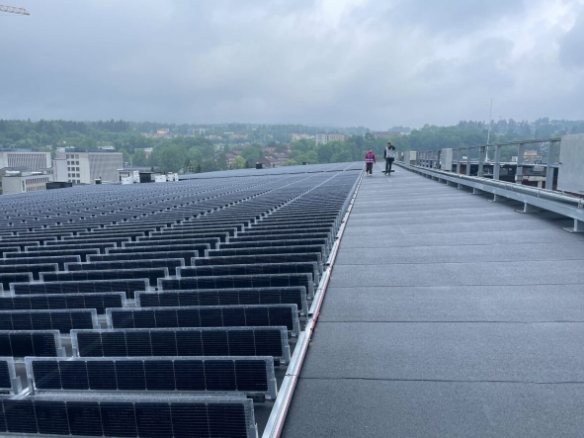
The vertical solar installation on top of Oslo’s Ullevaal Stadium
The 248 kW system deployed on top of Oslo’s Ullevaal Stadium has now been operational for over six months. It features 1,242 vertical solar cells, developed and supplied by Norwegian start-up Over Easy Solar, capable of producing almost 220,000 kWh annually.
Analysis carried out by Over Easy Solar to assess the array’s profitability calculated the money Ullevaal Stadium saves when compared to buying electricity at the spot price on the Norwegian market. The results found the system delivered slightly higher value per installed output than a similar horizontal system delivered last June.
Trygve Mongstad, CEO and Founder of Over Easy Solar, told that as dynamic power prices peak early in the year and drop down in summer due to an ‘overflow’ in solar energy, vertical panels are capable of producing higher value per installed output than conventional mounting.
“Vertical panels, especially south-north oriented panels in northern latitudes, deliver a larger proportion of the energy during the late winter and early spring,” Mongstad explained, adding that this means financial yields from solar installations during the winter can be higher than in the summer.
In the analysis of Ullevaal Stadium, February proved to be four times more profitable than August due to much lower electricity prices in summer months. “This is kind of surprising, especially for Norway where most people believe that there ‘is no sun' in the winter,” Mongstad added.
According to reports in Norwegian energy magazine Europower, the results of Over Easy Solar’s analysis show that Ullevaal Stadium’s target for deploying a vertical solar system, which was to get more energy in late winter and early spring, is being met. Europower's report adds that a better distribution of electricity production across the year means the stadium is able to use more of the electricity itself, saving from network rent and electricity fees.
In January, a case study analysis by Over Easy Solar found vertical rooftop arrays outperform conventional rooftop systems during snowy months, with energy yield up to 30% higher during winter in Norway.